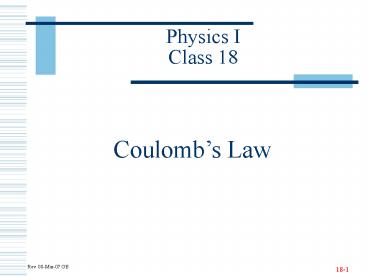Physics I Class 18 - PowerPoint PPT Presentation
Physics I Class 18
Problems of the Day. 18-16. Activity #18. Coulomb's Law. 18-17. Class #18 ... Beginning with the discovery of the electron in 1898, physicists encountered an ... – PowerPoint PPT presentation
Title: Physics I Class 18
1
Physics IClass 18
Coulombs Law
2
Forces Known to Physics(Review)
3
A New Property of Matter -Charge
4
Conservation of Charge
5
Coulomb - A Man, A Unit, A Law
6
Coulombs Law ofElectrostatic Force
7
Direction of Electrostatic ForceOpposites
Attract
8
Properties of Electrostatic ForceSimilarities
with Gravity
9
Properties of Electrostatic ForceDifferences
with Gravity
10
Comparison of Gravity and Electrostatic Force
11
Superposition ofElectrostatic Forces
12
Two Ways of Calculating theElectric Force Vector
13
Class 18Take-Away Concepts
14
Class 18Problems of the Day
15
Class 18Problems of the Day
16
Activity 18Coulombs Law
17
Class 18 Optional Material A Prof. Bs Method
of Calculation
18
How to Calculate aGeneral Unit Direction Vector
A unit vector is a specialvector with
dimensionlesslength of one unit.
19
How to Calculate the Electric Force Vector (Prof.
Bs Method)
20
Class 18 Optional Material BThree Quarks for
Muster Mark
21
Elementary ParticlesAn Embarrassment of Riches
Beginning with the discovery of the electron in
1898, physicists encountered an increasing array
of so-called elementary particles. It became
evident to physicists in the 1960s that these
particles must themselves be combinations of
deeper fundamental particles.
Joseph F. Alward, PhD Department of Physics
University of the Pacific
22
The Origin of Quark Theory
1929-
In the early 1960s, Gell-Mann and others
proposed the Quark Theory to explain the
elementary particles and their interactions in
terms of 3 deeper fundamental particles called
quarks. Further developments have shown there
are actually 6 different quarks and their
corresponding anti-quarks. The quarks and their
properties have been given whimsical names like
charm that have no physical significance.
Murray Gell-Mann tookthe name quark from "Three
quarks for musterMark", in James Joyce'sbook
Finnegan's Wake.(1963) (Nobel Prize 1969)
23
6 Quark Building Blocks
Quarks
Anti-Quarks
Anti-Bottom
PowerShow.com is a leading presentation sharing website. It has millions of presentations already uploaded and available with 1,000s more being uploaded by its users every day. Whatever your area of interest, here you’ll be able to find and view presentations you’ll love and possibly download. And, best of all, it is completely free and easy to use.
You might even have a presentation you’d like to share with others. If so, just upload it to PowerShow.com. We’ll convert it to an HTML5 slideshow that includes all the media types you’ve already added: audio, video, music, pictures, animations and transition effects. Then you can share it with your target audience as well as PowerShow.com’s millions of monthly visitors. And, again, it’s all free.
About the Developers
PowerShow.com is brought to you by CrystalGraphics, the award-winning developer and market-leading publisher of rich-media enhancement products for presentations. Our product offerings include millions of PowerPoint templates, diagrams, animated 3D characters and more.































